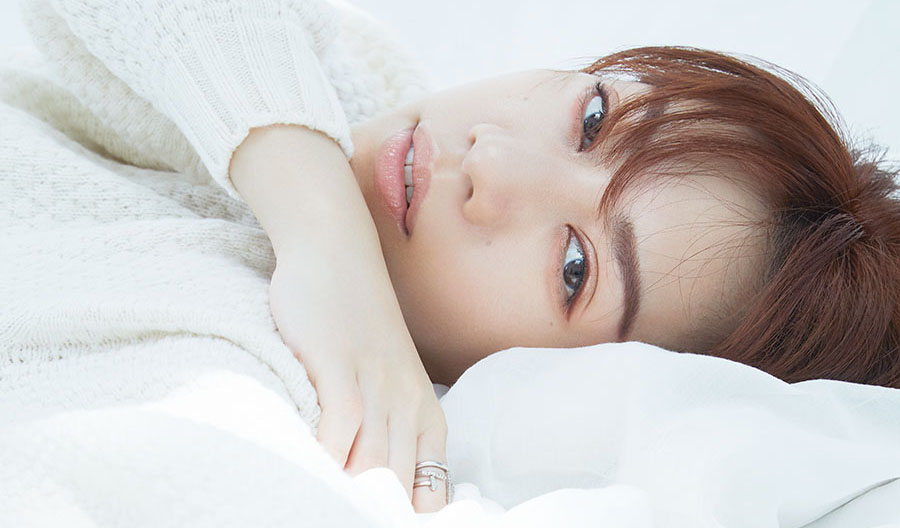
From the cool and mysterious aura of a beautiful woman, to the toughness of a young man, or even the mischievousness of a boy——Artist Miya Rurika explores the possibilities of beauty with more freedom.
Making “Miya Rurika” Into a Personal Gender
The gender “Miya Rurika”—neither a man, nor a woman, but a completely unique existence.
From among the otokoyaku (male role players) of the Takarazuka Revue, whose job it is to portray an ideal sort of manliness, Miya Rurika, who is known for having an androgynous style, is deliberately lifting the constraints of “gender,” and forming a gender-ambiguous persona—and in doing so has cleared a path for a new genre: a paradoxical, perverse sort of beauty. However, as a member of the Takarazuka Revue, Miya agonized over the right way to be as an otokoyaku, and faced quite a bit of conflict.
“I entered the revue with aspirations to be an otokoyaku, and although it did work out that way, I’m not very tall in stature, and my body is very slender, so I was cast in quite a lot of roles as androgynous characters, and to be honest I felt like I’d hit a dead end. I really stressed over the gap between my reality and the ideal I’d drawn up in my mind, and I worked frantically to compensate for the areas in which I was lacking.
But when I transferred from Star Troupe to Moon Troupe, I thought, why don’t I make a fresh start!—for better or for worse, without tying myself to the constraints of the otokoyaku image I’d held thus far. I’ll play female roles, I’ll play the androgynous male roles. Then I started receiving feedback from a lot of fans that they liked that I was different from other otokoyaku, and in my 10th year I was finally able to start believing that I should consider my individuality my strong point and take it to its extreme.”
One performance that gave a strong impression of “the gender Miya Rurika” was BADDY (2018).
Sweetheart, a mysterious and sexy character who appears to shift back and forth between male and female, is beloved by many fans as the role that suited Miya the most.
“The instinctive ease with which I was able to play that role, as someone who is naturally androgynous, became one of the factors that ultimately led me to decide to retire.”
Having retired from Takarazuka, Miya is attracting attention not only as a stage performer, but also as a “gender-free icon.”
“I think maybe my retirement has aligned well with the times. The reason I’ve chosen to brand myself as an “artist” rather than an actor or an actress is to position myself not categorized as masculine or feminine, but something neutral in between male and female, because I enjoy leaning in either direction depending on the role.”
Translator’s note:
I translated this as faithfully as possible, but given the sensitive and deeply personal nature of gender identity, I am a bit afraid that in unleashing it on an English-speaking audience, much of which may be influenced by Western biases, I may be unintentionally framing it as a coming out article, which I do not believe it is. It IS a very exciting discussion of the gender-based limitations that have thus far been prevalent in the Japanese entertainment and beauty industries, and Miya’s intentions to build a career out of dismantling them.
I am FULLY aware that I am not Japanese, and despite my familiarity with the language/culture and Takarazuka, my insights are thus limited. I WELCOME corrections/discussion preferably from Japanese people, but also non-Japanese people with more immersion/study/experience than I have. You can always email me (or LINE me if we’re already friends).
That said, I would suggest that you keep the following context in mind in reading this translation:
- It is extremely rare for a Japanese entertainer to come out. A coming out announcement would most likely be treated as a press release (or tabloid scoop tbh) and covered in news outlets, not explored in a fashion/beauty/lifestyle editorial.
- The Japanese entertainment industry, and Takarazuka to an even greater extent, places a lot of emphasis on manufactured personas. You will often hear Takarazuka OGs refer to their stage name as a different person entirely, even if they continue using it in their post-Takarazuka careers. In several post-retirement interviews, Nanami Hiroki described “otokoyaku Nanami Hiroki” as dead, and “artist Nanami Hiroki” as a brand new persona she was just starting to build. In the Sept. 8 2020 episode of her radio show, Ichijou Azusa, having just publicly announced her marriage, said that Ichijou Azusa is a different person, he’s a man, and he will never marry. The language used in the original text of this article is consistent with treating “Miya Rurika” as one such persona. Miya Rurika may have been labeled as “gender-free,” but we cannot take that to mean [real name redacted] has come out as trans, nonbinary, gender fluid, or otherwise.
- Japan has a much longer and more diverse track record of promoting gender-nonconformity in men/AMAB people (see Visual Kei, etc) than it does in women/AFAB people. We may scoff at the idea of androgyny being a novel concept in fashion modeling, but this article is not off base in stating that Miya is blazing a trail in Japan.
- The Japanese terms commonly used for discussion of nonbinary gender identities in Japan are ノンバイナリージェンダー and Xジェンダー. The terms used in the article (中性的、男性と女性の間、ジェンダーフリー) I have understood to be descriptors of external gender expression.
I am going the extra mile to provide this context both so I do not unintentionally promote something that Miya may not have intended, and so that we as foreign fans don’t lose sight of where Japan realistically is in terms of progress.
